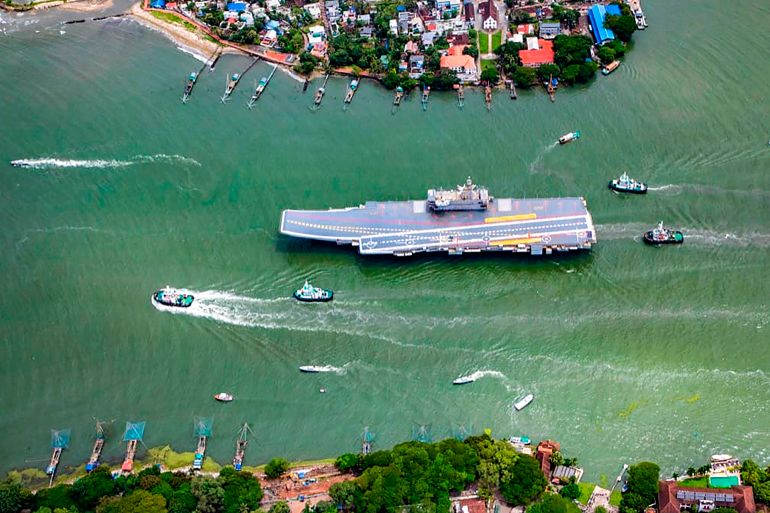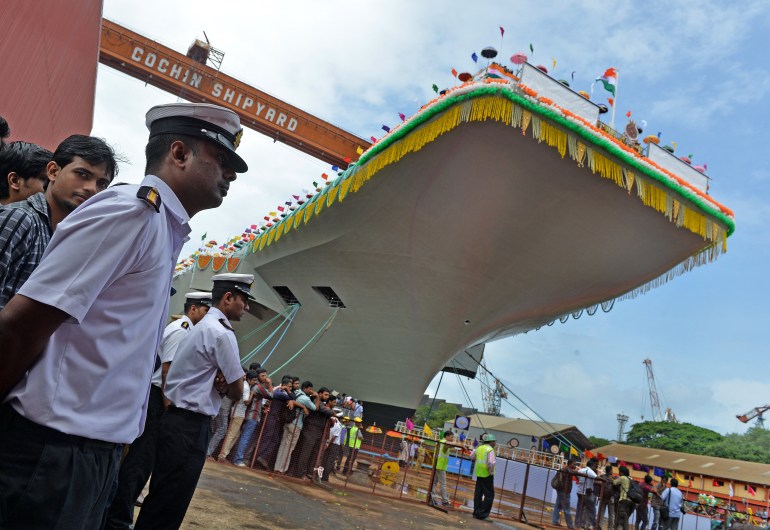India launches new aircraft carrier as concerns over China grow
INS Vikrant is the largest warship built in India and can carry a crew of 1,600 and operate a fleet of 30 fighter aircraft.

India has commissioned its first home-built aircraft carrier as it seeks to counter China’s much larger and growing fleet of warships and also expand India’s indigenous ship-building capabilities.
The INS Vikrant, whose name is the Sanskrit word for “powerful” or “courageous,” is India’s second-largest operational aircraft carrier and joins the Soviet-era INS Vikramaditya that was bought from Russia in 2004 to defend the Indian Ocean and Bay of Bengal.
Keep reading
list of 3 itemsThe battle for the Pacific: The countries competing for supremacy
UK, India agree to step up defence, trade cooperation
Designed by the Indian navy and built in the Cochin Shipyard in southern India, the new 262-metre (860-foot) INS Vikrant was launched by Prime Minister Narendra Modi on Friday as part of the country’s commemoration of 75 years of independence from British rule.
More than just adding to the country’s naval capabilities, Modi stressed the importance of India now being only one of a handful of nations with an indigenous aircraft carrier production programme.
“It’s a historic day and landmark achievement,” Modi said. “It’s an example of the government’s thrust to make India’s defence sector self-reliant.”

The carrier is the largest warship to be built in India, and can carry a crew of about 1,600 and operate a fleet of 30 aircraft, including fighter jets and helicopters, the navy said.
The Vikrant will initially rely on Russian-designed MIG-29K fighter aircraft that already operate from the INS Vikramaditya.
The 47,400-tonne warship will be fully operational by the end of 2023 after first undergoing landing trials with the MiG-29K aircraft. India also plans to equip the carrier with more than two dozen new fighters, with the Rafale-M from France’s Dassault and the F/A-18 Block III Super Hornet built by Boeing currently being considered.
More than 75 percent of India’s new aircraft carrier’s components were indigenously procured, with half a dozen large industrial firms and more than 100 smaller businesses providing equipment and machinery, according to the defence ministry.
A delay of six years in construction caused a six-fold price overrun to 200 billion Indian rupees ($2.5bn) at present, according to defence experts.
India employs 1.38 million people in its armed forces, with large numbers deployed on borders with nuclear-armed rivals China and Pakistan.
Chinese expansion
In recent years, China has expanded its presence into the Indian Ocean, the Western Pacific and beyond.
In August, Beijing sailed a navy vessel to a Chinese-built port in Sri Lanka despite security concerns from New Delhi about such a port call just off India’s own coast.
Beijing called the ship a research vessel but it was widely believed to be a dual-use spy vessel that India feared could be used to monitor the region.
In response to concerns over China’s growing assertiveness in the region, the Indian navy last year sent four warships to Southeast Asia, the South China Sea and the Indo-Pacific for exercises with members of the other “Quad” group of nations – the United States, Japan and Australia, according to India’s defence ministry.
Modi said on Friday that security concerns in the Indo-Pacific region and the Indian Ocean have been ignored for too long.
“Today, this area is a big defence priority of the country for us. So, we are working in every direction, from increasing the budget for the navy to increasing its capacity,” he said.
‘Blue water’ force
The Indo-Pacific’s vast maritime region has been tense because of China’s territorial disputes with its neighbours, including Taiwan, the Philippines, Indonesia, Vietnam, Japan and South Korea. There are competing claims for all or part of the strategically vital waterway that holds significant undersea oil and gas deposits.
China’s People’s Liberation Army Navy, or PLAN, has been modernising for more than 10 years to become more of a “blue water” force – one capable of operating globally rather than being restricted to remaining closer to the Chinese mainland. Aircraft carriers are critical for such a task.
The PLAN currently has some 355 ships, including submarines, according to the US Defence Department, which estimates that the force will grow to 420 ships by 2025 and 460 ships by 2030.
China’s two aircraft carriers were joined by a third one in June. The new aircraft carrier is believed to be fitted with an electromagnetic aircraft launch system similar to the system the United States uses in its new carriers. The Indian carrier uses the traditional “ski jump” type system to launch its aircraft.
India’s naval fleet now includes two aircraft carriers, 10 destroyers, 12 frigates and 20 corvette ships.
India’s older aircraft carrier, the INS Vikramaditya, was built in the Soviet Union in 1987. It served with the Soviet navy under the name Admiral Gorshkov, and later with the Russian navy before it was decommissioned in 1996.
India purchased it in 2004 for $2.35bn.